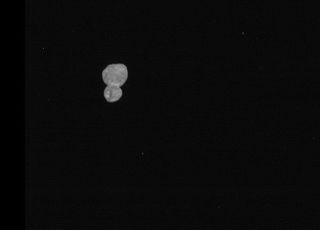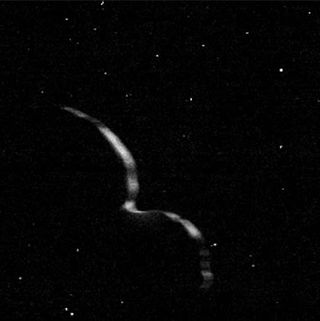In the early hours of 2019, NASA's New Horizons zipped past the Kuiper Belt Object 2014 MU69, making the most distant spacecraft flyby ever performed. Over the last 12 months, researchers have teased a lot of information out of the images captured over the few hours leading up to and after the exploration of one of the most primordial objects in the solar system.
"It seems like it was just yesterday—time flies!" New Horizons co-investigator Fran Bagenal, a researcher at the University of Colorado Boulder, told Space.com by email.
Team member Kelsi Singer, a planetary scientist at the Southwest Research Center in Colorado, echoed the sentiment. "I can't believe it was already a year ago," Singer said.
Within the first week, researchers knew that MU69, now officially named Arrokoth, was made up of two flattened lobes, more like joined pancakes than a space snowman. In the intervening months, they determined the precise sizes of the lobes and their densities, measuring surface brightness and crater scars.
Video: Relive NASA's Historic Kuiper Belt Flyby of New Horizons
Related: New Horizons' Arrokoth Flyby in Pictures
A year of images







New Horizons flew past 2014 MU69 on January 1, 2019 at 12:33 am EST, buzzing only 2,200 miles (3,538 km) above the object’s surface. When the spacecraft approached Arrokoth, all researchers had was a measurement of the object's size and orbit and a rough understanding of its reddish color and relatively unchanging brightness. The first few moments put much of that uncertainty to rest.
Arrokoth consists of two lobes. The larger lobe, nicknamed Ultima, is approximately 13.5 miles (22 kilometers) long, 12 miles (20 km) wide, and 4 miles (7 km) thick. The smaller lobe, Thule, is more circular, roughly 8.5 miles (14 km) by 8.5 miles (14 km) with a thickness of 6 miles (10 km).
According to observations, the two lobes most likely formed at about the same time more than 4.5 billion years ago, at the dawn of the solar system. While they experienced some light cratering—including a massive blow that left Maryland, an extensive crater on Ultima that stretches 4.3 miles (7 km) across the surface—Arrokoth remains relatively unscathed since its birth. Scientists expect that impacts came early in Arrokoth's lifetime, then tapered off, making it one of the most pristine bodies in the solar system.
"I find it fascinating that Arrokoth is so lightly cratered," Singer said. The dearth of scars suggests that the Kuiper Belt Object (KBO) changed very little since its early birth. Most of the craters are surprisingly large, with few mid-sized or small craters scarring Arrokoth. "That tells us that there are not a lot of small objects out there," Singer said.

Its early origin was one of the primary reasons Arrokoth was selected for exploration. Scientists had hoped that they would be able to catch a glimpse of the building blocks of early solar system formation in the KBO, a hope that Arrokoth more than fulfilled. The lack of scarring around the neck, where the two lobes joined, suggest a gentle collision. This led researchers to surmise that Ultima and Thule likely formed separately at about the same time, then slowly spiraled into one another to create a single object.
"I think it's really interesting that people can look at the two parts of the object and estimate that they must have come together so slowly, almost equivalent to walking pace," Bagenal said.
Arrokoth rotates on its axis once every 16 hours as it makes its 293-Earth-year orbit around the sun. Unlike Earth, whose rotation axis is roughly perpendicular to its orbit, Arrokoth keeps its north pole pointed towards the sun, resulting in long polar days and nights when regions may receive decades of daylight or darkness.

New Horizons also mapped the features of Arrokoth, charting its composition, bright spots, and fractures across the surface. The most volatile ices long ago escaped from the tiny object, but methanol, acetylene, ethane and hydrogen cyanide would have been retained. As radiation from the distant sun and other stars hit Arrokoth, hydrogen would have slowly been released, turning the ices into material known as tholins. On Pluto's moon Charon, an earlier target of New Horizons, tholins create the reddish cap at the north pole. They may also be responsible for the reddish color of Arrokoth.
Not all of New Horizons' data has been returned to Earth.
Although Singer said that all of the images from closest approach have returned to Earth, the spacecraft will continue to send home data until the mid-2020s at a speed of only a few bits per minute. Once it has all returned to Earth, the team hopes to begin the hunt for the next target using telescopes back on Earth.
"The team has made a ton of progress on interpreting Arrokoth and what it means for solar system formation," Singer said. "It is still amazing to me that humanity now has pictures of one of the most primordial objects in our solar system."
And New Horizons's work may not be finished.
Alan Stern, the principal investigator of New Horizons, has said the mission team is still looking for other flyby targets that may arise in the Kuiper Belt.
"So as we look forward to the 2020s, our team is planning the next few years for New Horizons," he said in a blog post earlier this month, adding that the search won't start until this summer. "We don't know how many KBOs we will discover or whether any will be within our fuel supply to reach for a final close flyby, but that's what these searches, in 2020 and again in 2021, will reveal."
Follow Nola on Facebook and on Twitter at @NolaTRedd. Follow us on Twitter @Spacedotcom and on Facebook.

Bagikan Berita Ini














0 Response to "One Year Ago, NASA's New Horizons Made the Most Distant Flyby in Space History - Space.com"
Post a Comment